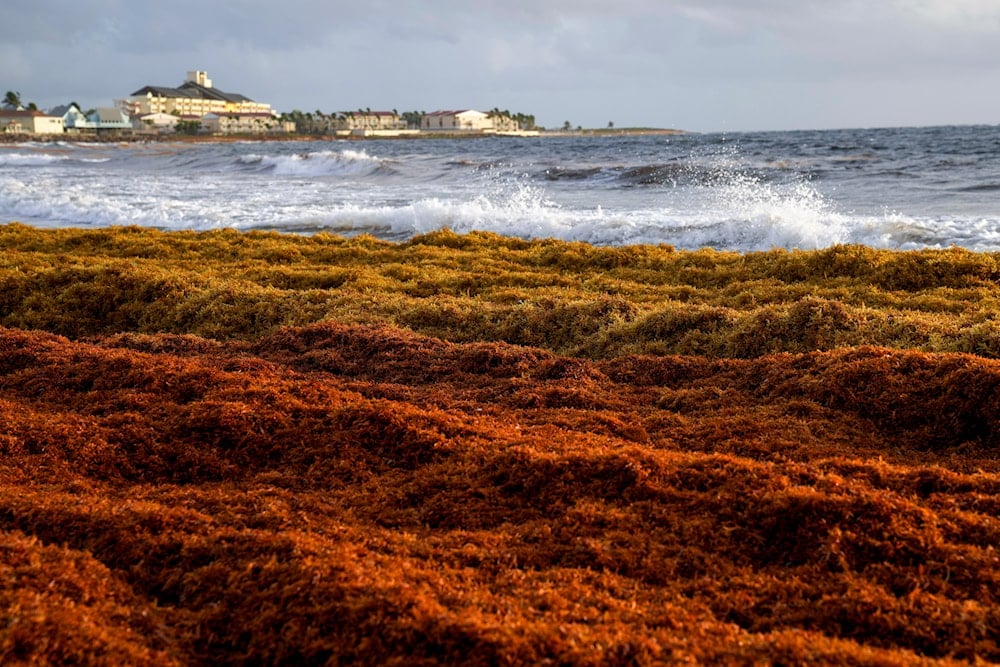Spanish beaches overwhelmed by invasive seaweed crisis
A Southeast Asian seaweed species is causing environmental catastrophe along Spain's coast, representing a broader global crisis where invasive marine species threaten ecosystems worldwide.
-

Seaweed covers the Atlantic shore in Frigate Bay, St. Kitts and Nevis, Aug. 3, 2022. (AP Photo/Ricardo Mazalan, File)
Since May, authorities in Cádiz in southwestern Spain have removed over 1,200 tons of Rugulopteryx okamurae, an aggressive invasive seaweed from Southeast Asia, from just one beach. On the worst day, crews hauled away 78 tons in 24 hours from La Caleta, the city's most popular stretch of sand.
"We're completely overwhelmed. This is an environmental catastrophe," José Carlos Teruel, responsible for Cádiz city council's beaches, told The Guardian. "Whenever the wind is westerly, we know we're in for another wave of seaweed."
This crisis exemplifies how invasive species, organisms introduced outside their native range, have become one of the planet's most destructive forces. Globally, invasive species contribute to 40% of endangered species listings and have driven 60% of known animal and plant extinctions. Scientists document negative impacts from 3,500 of the 37,000 alien species introduced worldwide, with new invasions occurring at an unprecedented rate of 200 species per year.
Rugulopteryx okamurae likely arrived in Mediterranean ballast tanks, the water ships carry for stability, when vessels traveling through the Suez Canal discharged their tanks. This pathway has become a superhighway for marine invasions as global trade increases.
First spotted a decade ago in Ceuta, Spain's North African enclave, the seaweed has since colonized the Strait of Gibraltar, Spain's southern coast, the Canary Islands, the Azores, and regions as far north as the Basque Country. Juan José Vergara, a biology professor at the University of Cádiz, warns that early intervention could have controlled the invasion.
"In the first phase of an invasion such as this it can be controlled. It's like catching cancer early on before it spreads," Vergara explained to The Guardian. "But now the scale of it makes it impossible to control."
Ecosystem devastation
The seaweed's impact demonstrates how invasive species trigger "invasion meltdown," where one invasion cascades through an ecosystem, preparing the grounds for subsequent invasions. Rugulopteryx okamurae attaches to rocks and floats freely, forming dense mats that smother native seaweeds and seagrasses. This displacement of native primary producers, the foundation of marine food webs, ripples through entire ecosystems.
The alga has no natural predators in the Mediterranean and reproduces both sexually and through fragmentation, making eradication virtually impossible. Its ability to absorb toxins and produce defensive compounds further enhances its competitive advantage over native species.
Beyond driving out indigenous plants at La Caleta beach, the invasion is restructuring underwater habitats. Native algal forests that serve as nurseries for fish and shelter for invertebrates are being replaced by simplified monocultures that support far fewer species.
Economic and social consequences
The seaweed's economic impact extends across multiple sectors. Tourism suffers as popular destinations like Cádiz and nearby Tarifa, a windsurfing hotspot, struggle with beach closures and unsightly conditions. Fishing operations face mounting costs as nets become entangled and oxygen depletion affects catch quality and quantity.
Disposal costs burden taxpayers, with current methods involving expensive transport to landfill sites. The Andalucía government recently launched a four-part response plan focusing on research, monitoring, education, and exploring biomass recycling options.
Vergara also informed The Guradian that recycling efforts alone cannot match the invasion's scale: "I doubt it will be able to eradicate or even significantly diminish the intensity of the invasion when hundreds of thousands of tonnes can wash up on a single beach."
A global threat
Spain's crisis reflects a worldwide pattern as similar invasive seaweeds are causing havoc globally. Caulerpa species have devastated Mediterranean and Californian waters, while San Diego recently declared an emergency over Caulerpa prolifera threatening native eelgrass beds.
Climate change and habitat degradation create increasingly favorable conditions for invasive species. Scientists predict the crisis will intensify, with future invasion hotspots including eastern USA, northeastern Europe, Southwest Australia, New Zealand, and Pacific Islands.
Current management strategies combine physical removal, chemical control, and biological control using natural predators, though each approach carries risks and limitations. Spain's neighbor, Portugal, has approved a national strategy for managing Rugulopteryx okamurae, emphasizing coordinated monitoring and rapid response. Meanwhile, Ireland is pioneering an approach which harvests invasive seaweeds for commercial use in food, pharmaceuticals, and cosmetics.

 4 Min Read
4 Min Read









